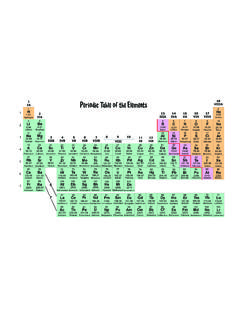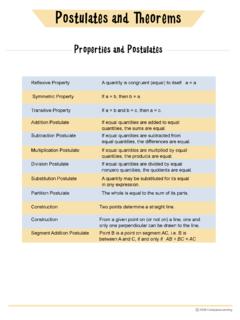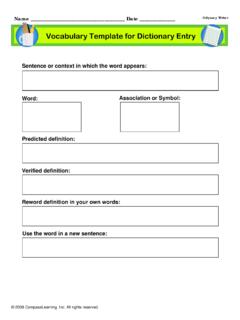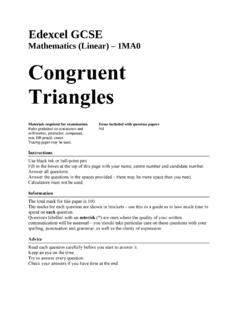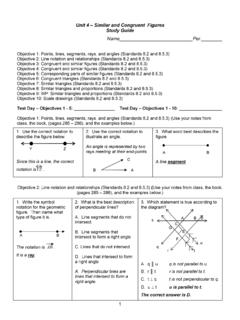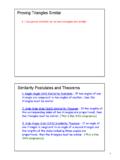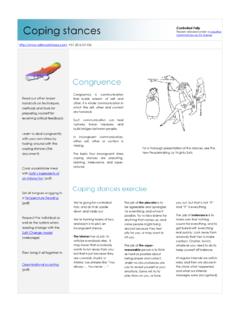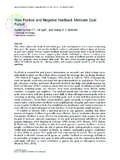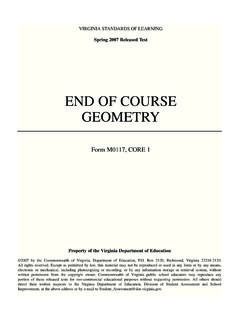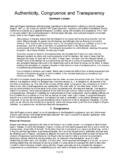Transcription of Show Me: Congruent and Similar M8127
1 show Me: Congruent and Similar M8127 An architect is planning a multi-story building with three rows of windows above the main floor. The windows in a given row are to be Congruent . The windows in the second and third rows are designed to be Similar to, but progressively smaller than, those in the first row. This is a kind of trick used by architects to make a building look taller than it actually is and has been used in many buildings in the real world. In this lesson, we will explore some examples of structures with Congruent and Similar parts. Andrea Palladio, an Italian who lived in the sixteenth century, is one of the most famous architects in history. Many of his building designs, such as the one shown here, consisted of a large central room in the shape of a square.
2 Rectangular and square rooms surrounded this central room. Together, these rooms formed a design that had certain symmetrical properties. Palladio believed that the dimensions of a perfect rectangular room should have a width-to-length ratio of six to ten. So, in this blueprint, the ratio of the width to the length of many of the rectangular rooms, is six to ten. Consider a room that is twenty-four feet wide by forty feet long. Do you think it would fit Palladio s definition of a perfect rectangular room? Certain kinds of bridges, called truss bridges, have supports that form Congruent or Similar shapes. In this example, the supports of the bridge form Congruent triangles. Let s recall what we mean by Congruent triangles. Two triangles are Congruent if they have the exact same shape and size.
3 When two figures are Congruent , all pairs of corresponding angles are Congruent , and all pairs of corresponding sides are Congruent . So, in this truss bridge, the triangles are all Congruent to each other. Let s label two of these Congruent triangles. We ll call the first triangle ABC, and the second triangle DEF. So triangle ABC is Congruent to triangle DEF. The way we order the labels when we write this congruence indicates which sides are corresponding, and which angles are corresponding. Corresponding angles of Congruent triangles are Congruent . So we can use information about the angles in one triangle, to find out about corresponding angles in the other triangle. For example, if we know that angles A and D are Congruent , and that the measure of the angle A is sixty degrees, then because Congruent angles have equal measures, the measure of angle D is also sixty degrees.
4 In a Similar way, we can say that side AB is Congruent to side DE. We know that Congruent segments have the same length. So, we can also write the length of side AB equals the length of side DE. Notice that when we are referring to the line segments that are the sides of the triangle, we write a bar over the top of the letters, but when we are referring to the lengths of these segments, we do not write a bar over the letters. Let s say that in these Congruent triangles, the length of side AB in the first triangle is six feet. What is the length of side DE in the second triangle? This truss bridge shows Congruent parallelograms. The four sides of each parallelogram are equal. When two polygons are Congruent , all pairs of corresponding angles are Congruent , and all pairs of corresponding sides are Congruent .
5 In this figure, parallelogram ABCD is Congruent to parallelogram SDMT. We also know that the corresponding angles in the parallelograms are Congruent , so we can say that angle A in parallelogram ABCD is Congruent to angle S in parallelogram SDMT, angle C is Congruent to angle M, and so on. See which other pairs of Congruent angles you can find. An engineer is studying these plans for the support beams of a bridge. If SDMT and RTNP are Congruent parallelograms, which statements are true? Congruence can be used by surveyors to determine distances that cannot be measured directly. For example, suppose that a surveyor standing at point E on the far side of a river wants to measure the distance AB across the river. Using her equipment, the surveyor conducts several measures to create two Congruent triangles, so that triangle EDC is Congruent to triangle ABC.
6 She finds that ED equals sixty-two feet. Since side ED corresponds to side AB in these Congruent triangles, then AB equals sixty-two feet also. Therefore the distance across the river between points A and B, is sixty-two feet. In this figure, triangle NPM is Congruent to triangle NQR. What is PM, the distance across the river? Two polygons are Similar if they have the same shape, but are not necessarily the same size. For example, on this quadrangular truss bridge, Similar triangles are created when triangles formed by the supports overlap. When two figures are Similar , their corresponding angles are Congruent , and corresponding sides are proportional. We can show that two triangles are Similar by writing this: triangle ABC is Similar to triangle MBP. As with congruence, the way the triangles are named, shows the angles and sides that correspond.
7 For example, angle A corresponds to angle M, angle B is shared by both triangles, and angle C corresponds to angle P. And if AB is twice MB, then BC is twice BP. If we know that BC equals fourteen inches, and that the ratio between the corresponding sides in these triangles is two to one, then we can write a proportion to find BP. Two is to one as BC is to BP. Substituting fourteen inches for BC, we can solve for BP by cross multiplying and dividing both sides by two. So, BP equals seven inches. In this figure, triangle ABC is Similar to triangle MBP. Suppose that the ratio between the lengths of the sides of the larger triangle ABC to the lengths of the sides of the smaller triangle MBP is two to one. If BC is twelve feet, what is BP? Surveyors also use similarity to calculate distances.
8 In this situation, a surveyor is measuring the width across a stream, shown by segment AB. She positions herself so that triangle ABC and triangle EDC are Similar . Side DE has a length of twelve feet, side CD has a length of five feet, and side BC has a length of twenty feet. Using these values, she can set up a proportion like this to find AB. AB is to BC as DE is to CD Substituting the values for DE, CD, and BC, we have that AB over twenty feet equals twelve feet over five feet. Cross multiplying gives us five times AB equals twenty times twelve, and dividing both sides by five, gives us AB equal to forty-eight feet. So, the width across the stream is forty-eight feet. This type of bridge is called a subdivided Warren truss bridge. It consists of vertical supports, between groups of Congruent and Similar triangular supports.
9 Let s look at this pair of Similar isosceles right triangles: triangle JKL and triangle RQU. The ratio between corresponding sides of the larger triangle RQU and the smaller triangle JKL is two to one. If the length of QU equals eighteen feet, what is the length of KL? Think about the answer, and then click Solution to see if you ve got it right. We know that triangle RQU is larger than triangle JKL, and that the ratio between corresponding sides of these two triangles is two to one. We also know that side QU corresponds to side KL. So we can write the following proportion: the length of side QU over the length of side KL is equal to two over one. Now the length of side QU is eighteen feet so substitute this for QU in the proportion. Next, cross-multiplying, we find that two KL equals eighteen feet, so KL equals nine feet.
10 This figure shows a plan for a lattice bridge made up of overlapping triangles. In this figure, triangle DEF and triangle GLH are Similar equilateral triangles and the ratio of the lengths of the corresponding sides in triangle DEF to triangle GLH is one to three. If the length of side DF equals four feet, what is the length of side GH? In this lesson we saw how we can use the relationships between sides and angles of Congruent and Similar polygons to calculate unknown lengths and angle measures. If polygons are Congruent , then their corresponding angles and sides are Congruent . If polygons are Similar , then their corresponding angles are Congruent and their corresponding sides are proportional. If you d like to review this activity again, click Review. If you re ready to exit, click Done.
